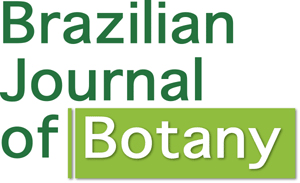The seeds of 14 species from the ‘caatinga’, a dry forest ecosystem of the semiarid region of northeast Brazil, were analysed for total protein and total lipid contents, as well as fatty acid distribution. The seeds of Argemone mexicana L., an introduced and naturalized species in Brazil, commonly found in ‘caatingas’ and other vegetation, were also analysed. The protein contents ranged from 123 g.kg-1 to 551 g.kg-1, higher contents being found in species of Leguminosae, but also in Jatropha mollissima (Pohl) Baill. (Euphorbiaceae, 409 g.kg-1). Oil contents ranged from 10 g.kg-1 to 400 g.kg-1. The contents of protein and oil were found to be inversely proportional in the seeds of most species, the figures for proteins being generally higher than those of oils. Most species presented either oleic or linoleic as predominant fatty acids. Cardiospermum cf. corindum L. presented eicosenoic acid as the predominant fatty acid.
Caatinga’; semiarid ecosystems; seed proteins; seed oils; fatty acids

